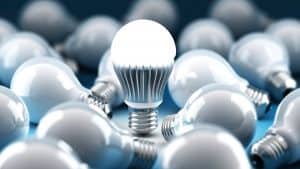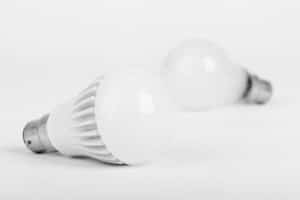GREEN Light
 With modern, energy-efficient technologies like LEDs, saving energy, as well as the environment, is easier than ever.
With modern, energy-efficient technologies like LEDs, saving energy, as well as the environment, is easier than ever.
LED lights are great examples of affordable, energy-saving, everyday products. LEDs represent an excellent deal for consumers, with multiple benefits.
Efficiency of LEDs

LED lighting is an energy-efficient, durable, and eco-friendly sustainable solution. As the prices of LED lighting fixtures continue to drop, and the efficiency of LEDs rises, they’re becoming more accessible to everyone.
A regular LED light, with moderate use, will last 10 years, or even longer. It will only benefit you to make a switch to light-emitting diodes and ditch the traditional lighting.
Need more convincing? Below are five major advantages of LED lighting that will have you switching out your old light bulbs in no time.
LED Lights - A Long-Lasting Illumination Method
One of the biggest advantages LED lighting has over conventional lighting options is its extended lifespan. LEDs last much longer compared to traditional light bulbs such as incandescent, halogen, and even fluorescent.
An estimated lifespan for a high-quality LED light bulb is a duration of 50,000 to 100,000 hours (which can be 10 to 20 years, given moderate use of the LED). LEDs also use over 75% less energy than incandescent bulbs.
Moreover, unlike other bulbs, LEDs don't burn out. Instead, the intensity of their light gradually decreases, which is commonly referred to as “lumen depreciation”.
So, LEDs continue to illuminate well beyond their given lifespan. When you take into account that the extended lifespan of high-quality LEDs is one of their regular features, it becomes clear that this green investment certainly pays off.
An Efficient Way of Ensuring Energy Savings
 Replacing old incandescent bulbs with LEDs has many asking whether this green investment is worth it. Investing in LED bulbs certainly makes more financial sense than other illumination methods.
Replacing old incandescent bulbs with LEDs has many asking whether this green investment is worth it. Investing in LED bulbs certainly makes more financial sense than other illumination methods.
Seriously, why get a 60-watt incandescent bulb when you can have a 20-watt LED one to do a better job using cheaper energy?
Given how the costs of LED bulbs have seen reductions of 85% in recent years, it becomes clear that LEDs are a wise choice. Making the switch to LED lights is one of the most efficient ways to ensure energy savings while also helping the environment.
A Powerful Solution for Perfect Visibility
Powerful illumination and high brightness levels are some of the key features of LED lighting. Compared to other traditional lighting options, they shine significantly brighter. What this means is that LED lights ensure better visibility.
This is of crucial importance in larger spaces such as sports venues, halls, and stadiums. It is for this reason that organizers turn to quality LED sports floodlighting in spaces where full visual comfort is imperative.
It’s a powerful solution for illuminating the playing court and providing optimal visibility for both the spectators and the athletes. Installing adequate sports lighting also brings reduced maintenance costs and significant energy savings. LED lighting represents the perfect choice for projects that require reliable lighting.
A Green Alternative With a Variety of Applications
Because of their versatility, LED lights have found their use in many different areas. From gaming and entertainment to the transportation industry to residential lighting, LED lights represent a green alternative with a wide range of applications.
Their ability to perform specific lighting tasks has also made LEDs a reliable go-to lighting solution for spotlights, accent lamps, security signals, and lighting signs.
LEDs are a popular choice for companies that are looking to design efficient office space, and manufacturers looking to reduce energy use. They’re also a great choice for businesses aiming to attract a consumer base that is eco-conscious, by offering environmentally friendly options.
Everyone can benefit from making the switch to LED lighting.
Environmentally Friendly Lighting Material
The manufacturing process of LED lighting is also environmentally friendly. Unlike traditional lighting sources that are made using mercury, LED lighting does not contain toxic elements harmful to the environment.
This means that LED lights don’t require any special handling after reaching the end of their lifespan. Unfortunately, the same can not be said for incandescent, fluorescent, and neon lights.
Once the time comes for you to replace your LED lights, you don’t have to worry about them posing a danger to the environment. The fact that they are made of non-toxic materials means they’re 100% recyclable, making them perfectly Earth-friendly.
The ongoing focus on sustainability has many of us looking for ways to reduce our carbon footprint and do everything in our power to protect the environment. After all, it’s our duty and responsibility to be more conscious of the world around us and reduce the impact of our actions on the planet as much as possible.
Switching to green, eco-friendly alternatives such as LED lighting is certainly the best place to start. Something as simple as making the switch to energy-efficient lighting is a small step you can take today to ensure a healthier, greener, and brighter tomorrow.
About the author: Lana is a stay-at-home mom, writer, and interior design enthusiast. She loves writing about interiors and green living, but her specialty is landscape design. She enjoys playing in the kitchen and cooking for her friends and family, spending time in nature, and learning about other cultures by traveling. She is a regular contributor to smoothdecorator.com
Here is a brief quote from the renewable energy aggregator and energy provider Arcadia about the various benefits of LEDs>>>
"LEDs use much less energy than incandescent bulbs because diode light is much more efficient, power-wise, than filament light.LED bulbs use more than 75% less energy than incandescent lighting. At low power levels, the difference is even larger. Bright LED flood lamps use only 11 to 12 watts while creating a light output comparable to a 50-watt incandescent bulb.
The initial cost of an LED used to be about double what an incandescent bulb cost. But the costs have been coming down, and now it’s hard to find bulbs that aren’t LEDs. That’s because they’re so much more efficient than incandescent bulbs that they save money in the long term.
That’s made them the go-to product for the lighting industry. The average American home has around 40 lightbulbs. Replacing all of those with LEDs could result in savings of $300 a year on energy costs...
Another advantage of LEDs is the “hassle factor.” LEDs last a lot longer than a regular bulb, which means you save the hassle of searching for the drawer you stashed the lightbulbs in – not to mention money on new bulbs. Manufacturers say an LED lasts for approximately 10 years, or 100,000 hours of continuous use."
[QUOTE FROM - blog.arcadia.com/led-vs-regular-lightbulbs-do-they-really-make-a-difference]
Please also see: